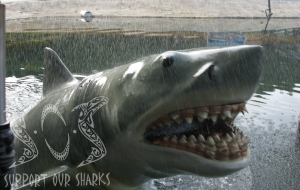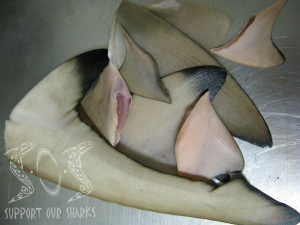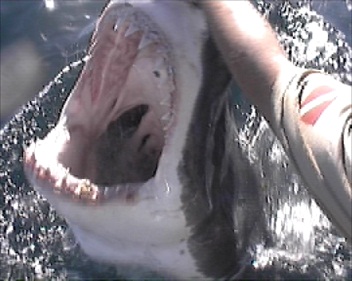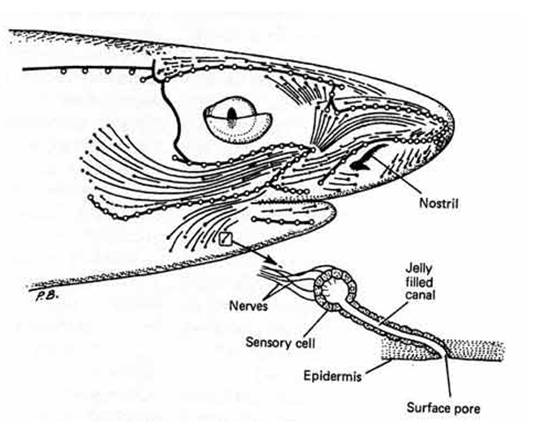Myth: ‘Sharks are vicious man-eaters’.
 Truth: Most sharks are far too small to be vicious killers of men
and women, and many sharks live in the deep sea where no humans
swim. The fact remains that around 50-100
shark 'attacks' occur each
year, and only about 2-4 of these result in death.
Truth: Most sharks are far too small to be vicious killers of men
and women, and many sharks live in the deep sea where no humans
swim. The fact remains that around 50-100
shark 'attacks' occur each
year, and only about 2-4 of these result in death.
Most
shark 'attacks' on humans are as a result of mistaken identity, in which the
shark picks up on signals similar to that of injured turtles or see's the silhouette of a surfboard,
which it may believe to be a sea lion. Sharks will take an
exploratory bite to determine whether the prey item is edible (as
they don’t have hands to feel their food) and then in the case of
humans, swim away if it is not. Unfortunately, a single bite
from a shark such as the great white (Carcharadon charcharias)
can result in the loss of a limb or be fatal due to the loss of
blood that ensues.
 Myth: ‘Sharks have no predators’.
Myth: ‘Sharks have no predators’.
Truth: The greatest predator of sharks is man. Man kills
up to
273 million
sharks each year. To give
some perspective, in just two years fishermen will kill more sharks
than the equivalent human population of the United
States. Humans are not natural predators of sharks, as we are
terrestrial hunters and didn't really fish for sharks until we
became 'civilised'. Now we cut off fins and throw the living
creature back to die on the bottom of the sea. Have we really
evolved? Some shark species are actually adapted to predate on other
sharks, like the bull shark. In theory, any large shark could
consume a smaller one, though this is not usually the case. Orcas
have also been known to consume sharks; even the Great White shark
has been known to be on the menu for orcas. However, the most
numerous natural enemies of sharks are the various parasites that
can kill them if they get out of hand.
Myth: ‘Sharks are mindless killing machines’.
 Truth:
Despite the common myth that sharks are instinct-driven eating
machines, studies have indicated that
many species possess powerful problem-solving skills, social
complexity and curiosity. The
brain-mass-to-body-mass ratios of
sharks are similar to those of mammals and other higher
vertebrate species. Sharks have a tendency to work together as
a team. Groups of sharks, roughly the same age and gender, tend to
return to the same area each year. Sharks have been observed
returning to a particular place and patrol the same bays every year
at the same time. Each year, they bask and communicate with each
other with body movements and are present at each other’s kills.
Truth:
Despite the common myth that sharks are instinct-driven eating
machines, studies have indicated that
many species possess powerful problem-solving skills, social
complexity and curiosity. The
brain-mass-to-body-mass ratios of
sharks are similar to those of mammals and other higher
vertebrate species. Sharks have a tendency to work together as
a team. Groups of sharks, roughly the same age and gender, tend to
return to the same area each year. Sharks have been observed
returning to a particular place and patrol the same bays every year
at the same time. Each year, they bask and communicate with each
other with body movements and are present at each other’s kills.
Myths: ‘All sharks are visual hunters’.
 Truth: Sharks are also able to locate prey using their
electrical sense, made up of pores known as the ampullae of
Lorenzini. Measurements demonstrate that a shark can detect electric
fields of a magnitude similar to a 1 volt battery placed in the
middle of the Atlantic Ocean, with the positive pole connected to
Boston Harbor and the negative pole placed in the harbor at
Plymouth, England.
The miniscule current flowing across the ocean
(1/1,000,000,000 volt per square centimetre) would be at a level
detectable by sharks. Translated to hunting, a shark can sense a
prey in turbid water or buried beneath the seafloor by electrical
sense alone. Hearing provides another cue. Sounds of struggling fish
will attract sharks from great distances. Their sensory systems are
highly evolved making them the apex predators of our oceans.
Truth: Sharks are also able to locate prey using their
electrical sense, made up of pores known as the ampullae of
Lorenzini. Measurements demonstrate that a shark can detect electric
fields of a magnitude similar to a 1 volt battery placed in the
middle of the Atlantic Ocean, with the positive pole connected to
Boston Harbor and the negative pole placed in the harbor at
Plymouth, England.
The miniscule current flowing across the ocean
(1/1,000,000,000 volt per square centimetre) would be at a level
detectable by sharks. Translated to hunting, a shark can sense a
prey in turbid water or buried beneath the seafloor by electrical
sense alone. Hearing provides another cue. Sounds of struggling fish
will attract sharks from great distances. Their sensory systems are
highly evolved making them the apex predators of our oceans.
